"You know my method. It is founded upon the observation of trifles."
Don't wanna be here? Send us removal request.
Text
Deducing from the Face
The face can be one of the most telling areas of the body in terms of mood and emotion, as well as certain habits. Here are several tips I have collected, particularly from aesthetic physicians that deal with the face and its intricacies extensively:
The ratio of frown lines on the forehead and between the eyebrows and laugh lines around the eyes can indicate which expression the individual is more prone to, and can act as a gauge for their long-term mood trends.
More sun damage (more wrinkles, tanner skin, more freckles, etc.) on the left side of the face as opposed to the right side (in countries were you drive on the right side of the road) indicate an excessive amount of time spent driving during daylight hours and can be a sign that you’re dealing with someone who works in the transportation industry. This is due to the fact that more light hits your face on the side with a window immediately next to it as opposed to the side without a window. The left side of the face would be the side to look at for people who live in countries where they drive on the left side of the road.
A very slightly enlarged side of the face indicates which side the person sleeps on. Namely, the side of the face that is slightly larger will be the side they sleep on, because blood can pool on that side of the face as they rest. Chronic pooling can then cause one side of the face to grow or swell very slightly. This in turn can be a sign of back problems or other chronic pain that would force the individual to sleep solely on one side.
Bonus: When people are genuinely interested in what someone has to say, they will often raise their eyebrows very subtly and slightly. It is an unconscious expression that most people are unaware of, and as such, it is a powerful piece of body language to understand if you know to look for it.
572 notes
·
View notes
Photo

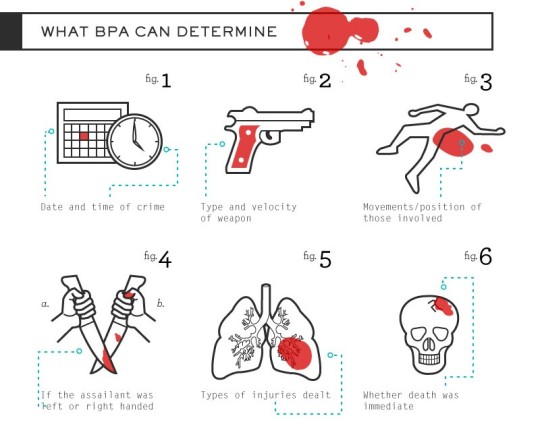
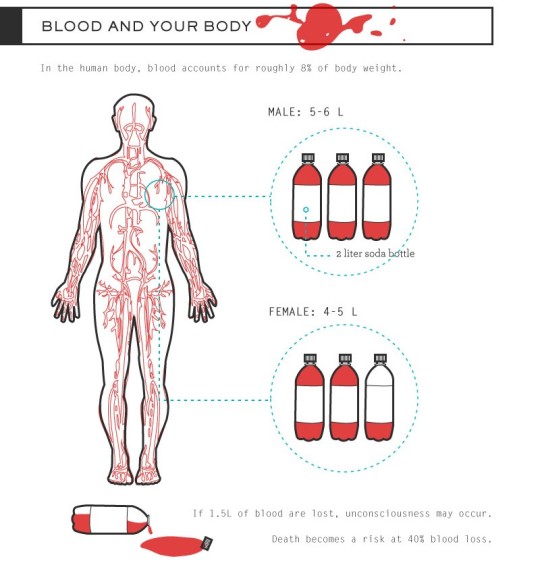

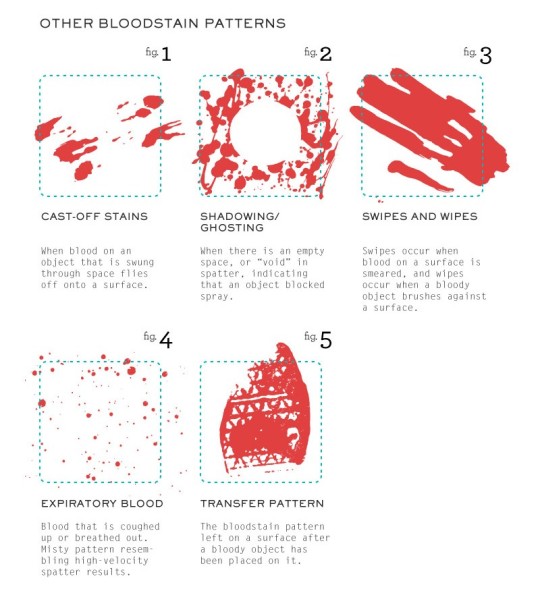


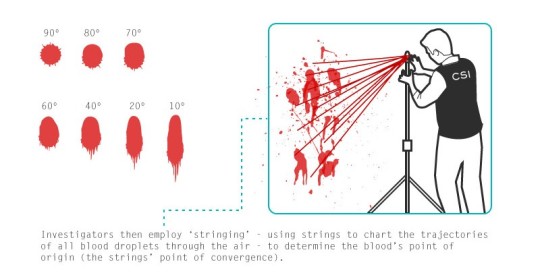
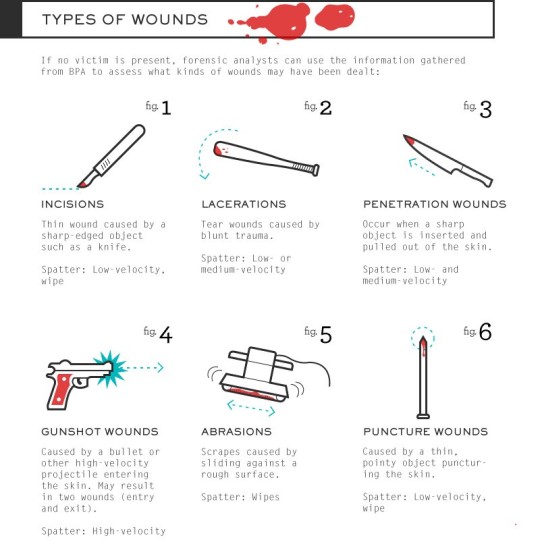
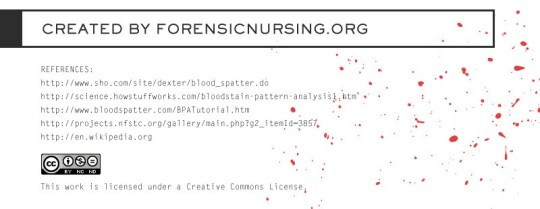
Bloodstain Pattern Analysis (BPA) - Resource for Crime Writers
SOURCE
194K notes
·
View notes
Note
I'm from australia and nobody I know nor myself ever checks and knocks our shoes for scorpions and spiders
This is an interesting piece of information. Do you live in a rural area or an urban area? Perhaps I am wrong in my initial assessment. In any case, I recommend taking up the habit. It saves one a nasty bite in some instances.
10 notes
·
View notes
Photo

A chart for determining the bullet name by size and shape.
132 notes
·
View notes
Text
Estimating the Number of People in a Group of Tracks

Two of the common methods used to determine the approximate number of people in a group from the tracks.
163 notes
·
View notes
Link
A good page featuring pictures of many common "foreign" paper notes. A more complete and less biased but limited list can also be found here.
A beautiful source for identifying coins can be found right here. For quicker reference, there is another, smaller list here.
24 notes
·
View notes
Text
Some Different Types of Tracks

Some of the common variations on tracks, besides walking.
532 notes
·
View notes
Text
Semaphore Code

A helpful chart for Semaphore Code. Memorization not necessary, but recommended, as especially in the military, Semaphore is more commonly recognized than even Morse Code sometimes.
100 notes
·
View notes
Text
Age of Footprints

Terrain and recent weather should also be taken into account when considering the age of tracks.
91 notes
·
View notes
Text
Area Codes for the US

A helpful chart of all the US area codes for reference. A online listing of them in order of number can be found here, and an excellent site for reverse phone lookup (if necessary) can be found here.
86 notes
·
View notes
Text
Shoes - Of Importance
Shoes are such a vital piece of information to an inquisitive mind that it is one of the first things one would look to when seeing a stranger. They are ranked with hands and face in terms of what I first look to when I should glance at someone. Here are some things to look for:
Type of shoes. This may sound elementary, but you would hardly look twice at dirty work boots, while high heels shoes with a fair amount of grime may attract staring even from the less observant sector of the populace. In either case, do not let the type of shoe predominate your data. Dirt on a sandal is just as important as dirt on dress shoes. Data shouldn't have scales. It simply is.
Clean and unworn: probably new shoes. Compare newness and cleanliness of shoes to that of the clothes. The gap (or lack thereof) in such a feature would be suggestive.
Clean and worn: older shoes, but the fact that they are clean means that this person most likely lives in the city, where they are far less likely to accumulate dirt and other debris.
Dirty and unworn: newer shoes, but examine the dirt. Is it of the same color as the dirt in the vicinity, or is it foreign? It could be the dark, wet earth of fertilizer or the fine, tan dust of drier regions. Dirt can tell you much if there is enough for you to gather the data necessary for deduction.
Dirty and worn: work boots. But be careful, the fact that they are worn and dirty would suggest less about the person's financial status and more on their view towards spending and personal effects.
Look to the obvious creases and cracks in the rubber. Are there any? If so, one can infer alot of bending over/physical activity in those shoes, as the act of doing so will crease or crack the weaker rubber linings. If not, then either that person is strangely inactive or they have a tight schedule and a dedicated workout time. With a different pair of shoes, obviously.
Look for scrapes or scratches that ware down the harder edge of the rubber sole. Location and prominence can indicate exactly how often this person may have reason to scrape their shoe. In a dry environment, this may indicate a dog.
Shoes are so varied and telling that more posts may follow on the possible information to be gleaned from them in the future.
491 notes
·
View notes
Photo

A stash containing samples of many different drugs.
30K notes
·
View notes
Text
Deducing from Nails
If you look at the thumbnail or index finger nail on the dominant hand and see that they have been clearly worn away, that person probably spent a good deal of time washing dishes, where the combination of water and scrubbing with your nails create wear.
Yellow stains on or around the thumbnail of the person's dominant hand indicate extensive use of tobacco.
Poor nail growth (often characterized by wavy or thin nails) can indicate regular alcoholism or poor nutrition.
If there is a blood spot under the nail, but it does not appear to be the cause of an injury, the person most likely has a congenital heart defect.
Another sign of a congenital heart defect or respiratory disease is when the nails "club", or curve excessively downward. This symptom is also known as Hippocratic Fingers.
Dirt under the fingernail can also be extremely useful. By glancing at the color of the dirt, it is usually easy to determine the approximate location or, if the dirt is unusually dark, it can mean they are a gardener or similar person who would work with fresh potting soil.
789 notes
·
View notes
Photo

A quick map of the electrical outlets used throughout the world. Click here to read more about each type.
184 notes
·
View notes
